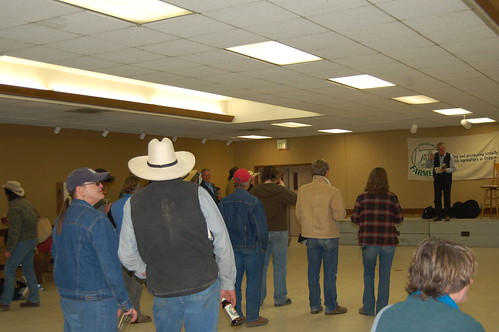What happens to food produced by a rain forest tree when it is eaten by animals or the tree dies?

Image by friendsoffamilyfarmers
Question by NiteAngel: What happens to food produced by a rain forest tree when it is eaten by animals or the tree dies?
Tropical rain forests are estimated to be responsible for more than 20% of global photosynthesis. It seems reasonable to expect that the rain forests would reduce global warming by consuming large amounts of CO2, but many experts now think that rain forests make little or no net contribution to reduction of global warming. Why might this be?
Add your own answer in the comments!

gets decomposed
bbaby166
June 2, 2013 at 5:57 am
They create heat when the locals burn them down to plant peanuts (or whatever).
Bacse
June 2, 2013 at 6:15 am
They just can’t make up their minds can they? Makes you wonder why they are so proof positive On anthromonkey induced Global Warming
vladoviking
June 2, 2013 at 6:49 am
Rain forests are for the most part, mature, climax forests. This means that they are not growing significantly, but have reached a level of stability. When a tree dies, it is eventually replaced by another. While the forest does process a huge amount of CO2, the amount does not increase because the forest doesn’t show net growth. So the rain forest can help keep global warming from getting worse, but it can’t do much to make it better. Still, the worst thing we can do is to cut it all down, which is happening at a frightening rate.
TG
June 2, 2013 at 7:42 am
when plants are eaten, they are used for energy, and you exhale CO2.
when they die, they are metabolized by bacteria, which exhale CO2.
the problem is that the rain forest would need to create more living matter, that didn’t die, or get eaten.
and that does not happen.
worse, all that rain tends to leach nutrients out of the soil and wash them down the river, so that many rain forests are not particularly rich growing environments.
linlyons
June 2, 2013 at 8:02 am
sustainable environments consume what they produce,and of what they produce ,wastes are consumed
byderule
June 2, 2013 at 8:09 am
Rain forests are mostly mature ‘climax’ forests. The maximum carbon uptake point is it at at peak growing not when the tree is mature. So it starts to take up carbon as soon as it is established. New growth sequesters most carbon, as long as you do not burn the timber or allow it to decompose it locks the CO2 in. If it is burned it only releases the same amount of CO2 as it took in unlike oil based products it is carbon neutral. So when the Rain Forest is mature, the majority of the trees have reached stability there is no net growth.
Now the bright among you will be screaming trees and animals in Rain Forests decompose. Correct and that is the second part of your answer. All living things get their energy by respiration. So oxygen is absorbed from the atmosphere and carbon compounds are split into CO2 and water, the CO2 is returned to the atmosphere. Living things can represent a sink keeping carbon out of the atmosphere but when living things die CO2 is returned to the atmosphere. Part of this, the decomposing bodies, decomposes very slowly and is stored in the soil in temperate climates. So soil is another carbon sink. The total amount stored in the soil organic matter is greater than that stored in living plants in temperate ecosystems. In temperate forests it is about twice as much. Tilling the soil exposes the soil organic matter to oxygen so greatly increases the rate of oxidation, that is the rate at which the decomposing microbes turn organic matter back to CO2 and water as they respire.
When Temperate Forest is ‘deforested’ and these virgin soils are plowed CO2, that has been fixed for thousands of years, is released back into the atmosphere. Repeated tilling of agricultural soils is a constant source of atmospheric CO2.
Worldwide soil carbon is estimated to amount to three times as much as that stored in the vegetation in ecosystems on land. BUT in Rain Forests the rate of decomposition is much much faster. The whole process is speeded up. The soils are very thin and most of the nutrients are in the mulch. But rain forests are subject to heavy rain, storms and flooding so the soils and mulches are frequently washed away, so not a carbon sink to anywhere near the same degree.
So we would have to responsibly manage Rain Forests by selectively cutting and coppicing to encourage new growth to sequester more CO2. However, Rain Forests are so fauna and flora rich and are vital to the ecosystem they are best left alone. That is their ability to sequester CO2 is secondary to their importance as intact Rain Forests.
Whitefield 2004 Earth Care Manual
Miguel 1995 Agroecology, the science of sustainable agriculture
Kourik 2004 Designing and Maintaining your Edible Landscape naturally
Renee 1992 Saving the Seed
Crop Genetic Resources in Biodiversity for Food and Agriculture FAO 1998
Permaculture bella
June 2, 2013 at 8:51 am
hey are u in mr henrys bio class?? lol
Chris M
June 2, 2013 at 9:02 am